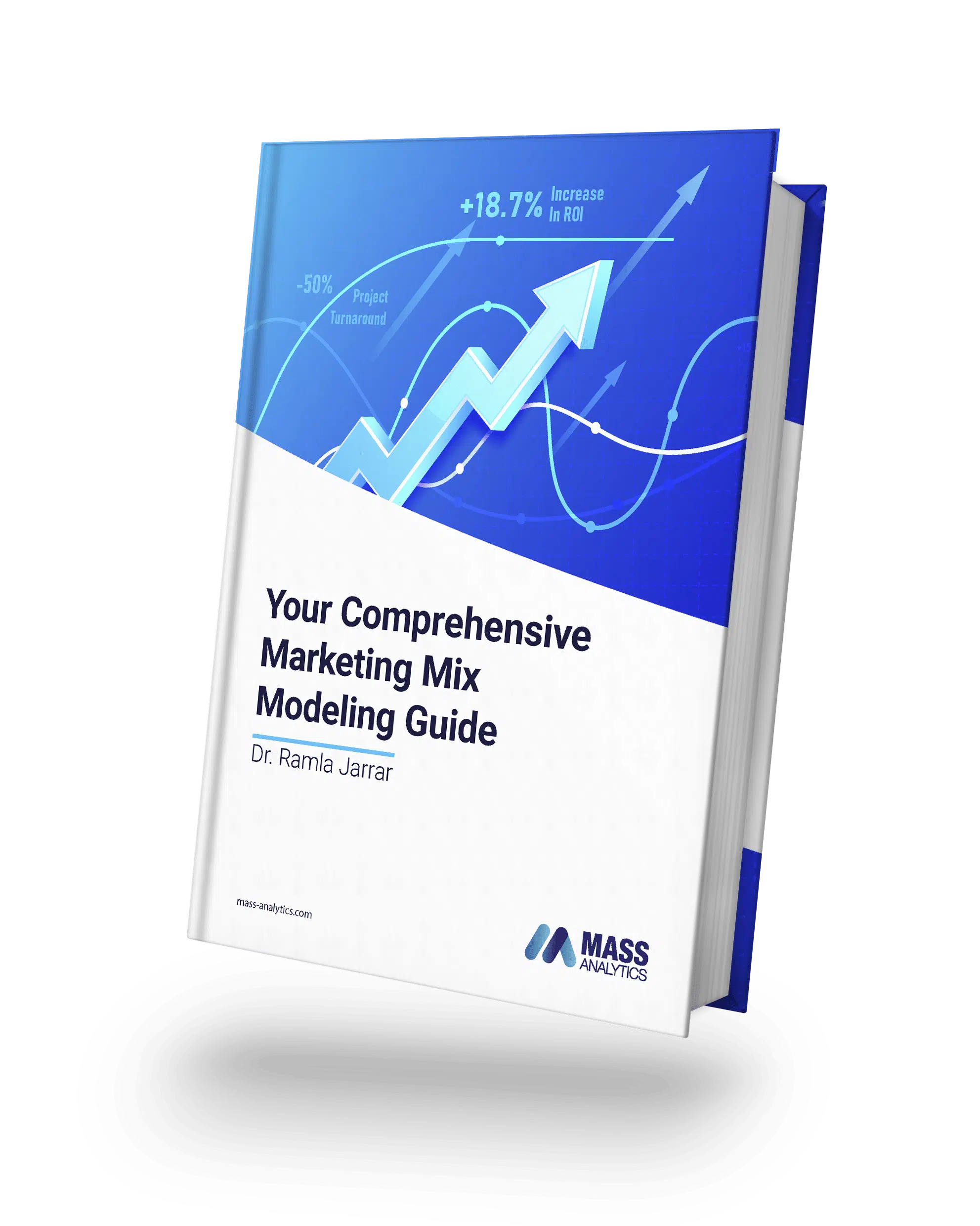Whitepaper:
Your Guide to Embracing
Contemporary Marketing Measurement

Marketing is a dynamic field that keeps increasing in importance year over year. Consumers’ interactions with brands, as well as their responses to marketing activities, are constantly evolving through paid, owned, and earned media. One of the primary problems facing this development is how to adopt effective measuring methodologies for online and offline media investments, which are resistant to signal loss and privacy compliance.
Advertisers are keen to develop measuring approaches that can be used to make both tactical and strategic media decisions. Marketing mix models (MMM) are now the stars among those approaches. They are becoming increasingly popular thanks to their ability to meet the marketers’ demands. In fact, The marketing sector is seeing a surge in in-house MMM development. In addition, digital-native marketers (as well as conventional ones) are flocking to MMM in droves.
There is a real need today for advanced modeling techniques that can empower marketers to harness insights from Marketing Mix Models and embrace a contemporary approach offering more granular results in a shorter timeline. In particular, Pooled Regression, Log-linear, and Nested Modeling are three techniques serving the needs of this new measurement paradigm.
Therefore, advertisers are more than ever demanded to understand more about these marketing measurement techniques. We hope this comprehensive guide will serve as a solid resource to help navigate a new measurement landscape by illustrating how these techniques could be used to empower our clients and partners.
Nested Modeling: How to Measure the Direct and Indirect Impact of Sales
The amount of marketing data produced, and the number of KPIs associated with marketing and communication, are proliferating as time passes. In this constantly evolving and dynamic setting, measurement becomes more complicated, and that is where Nested Modeling comes into play.
What is a Nested Model?
A Nested Model depicts an immersive relationship between multiple linked KPIs and independent drivers. Two models are nested if one model contains all the variables of the other in addition to (an) other variables. A typical example largely encountered in Marketing Mix Modeling is TV advertisement and paid Search. In fact, it is largely expected that:
- TV advertisement impacts sales directly, i.e., consumers buy the brand following the exposure to TV advertisement with some delay modeled through carryover/Ad Stock.
- TV advertisement impacts search as some consumers exposed to the TV commercial will search for the brand ahead of buying.
In this case, we cannot have search and TV as independent variables in the same equation without considering that an intermediary step as Search is not independent of TV. Technically, this is called an endogeneity problem. To measure the above setting, we use Nested Models where the Sales model is considered as the complete (or full) model, and the Search model is the smaller, reduced, or restricted model.

Advantages of Nested Modeling
Nested Modeling allows the user to measure the direct and indirect impact of each sales driver. This is very useful, especially when reporting on offline and online channels’ interaction, where multiple touchpoints are used.
Nesting brand indicators, such as awareness, consideration, and other brand-related metrics in the main sales equation (the full/complete model) allow the client to measure, for example, the so sought-after brand impact.
Benefits of using Nested Modeling include:
- Quantifying the true relationship between Paid, Owned, and Earned Media.
- Adjusting sales contribution by considering the indirect impact.
- Providing more accurate interpretations by calculating the influence of omitted variables.
- Gaining a complete view of the brand’s ROI.
- Adjusting ROI measurement and optimization based on a thorough analysis of all touchpoints.
Challenges of Using Nested Modeling
Nested Modeling is a powerful technique to disentangle the direct and indirect impact of different sales drivers. However, it brings its own list of challenges. For starters, modeling the interactivity of different media variables in a sophisticated contemporary landscape is a resource-heavy process.
The complexity of Nested Modeling is related to its multiple levels compared to classic modeling. Introducing multilevel modeling to marketing measurement means the creation of a significant difficulty due to the sheer number of indirect impacts to be calculated. If this measurement is conducted across different product lines, the process gets even more complicated.
Due to the complexity and scale of calculations needed in applying the Nested Modeling methodology, a new set of skills and approaches is needed to tackle it. The manual calculation is simply not a viable solution to implement this type of model. Specialized MMM tools are essential for this technique.
They introduce a degree of automation that can turn it from a heavy investment into an achievable endeavor. Powerful solutions can automate a large portion of the data preparation and data processing phases. These are known to take long in traditional MMM projects. Additionally, Machine Learning algorithms can be leveraged to streamline modeling and ensure that the modeler’s time is spent on calibrating and extracting insights from the model instead of processing the data or going through the heavy calculation that the nested models entail.
Nested Modeling: MASS Analytics Solution
The Nested Model approach implemented in MassTer, MASS Analytics’ end-to-end modeling platform, is an improvement over the currently used approach by the industry and is believed to offer more accurate results with more sound and economical interpretations, more specifically:
- No limitation on the number of models to be nested (i.e. the reduced models). This allows the user to better model complex real-life touchpoints.
- An automated attribution screen, specifying the direct and indirect impact of each variable.
- ROI and Optimization calculations are adjusted to account for the indirect impact leading to more accurate results.
- Preservation of the stationarity assumption of the underlying OLS method by providing constant time-independent coefficients.
- Allowing the quality of the Nested Model to affect the resulting final model, hence preserving an accurate overall picture.
- Assigning part of the base component of the Nested Model to the base of the main model
- Reducing model variables still shows in the main model.
- Variations of the Nested Model could be easily used (e.g. lagged, decayed…) allowing for example to capture brand effect.
MASS Analytics promotes a contemporary MMM approach delivering faster, automated, and dynamic models powered by Machine Learning to accurately measure the impact of media and marketing in a complex and interactive media landscape.
Pooled Regression: Highly Accurate Marketing Mix Models
In a world characterized by the increasing availability of data, classic MMM based on national modeling falls short of marketers’ expectations when it comes to the provision of granular insights necessary for data-driven decision-making. In particular, Regional Modeling, also known as Pooled Regression, is becoming increasingly popular in this new paradigm.
With access to granular data points like Regions/DMAs, Stores, and even consumer segments, cross-sectional or regional modeling can provide marketers with detailed insight into consumer behavior specific to the region or store location.
What is Pooled Regression?
Pooled Regression is usually carried out when we have available time series of cross-sections i.e., data that has observations over time for several groups or cross-sections. A cross-section could be a region, store, DMA, consumer segment, etc. Fixed Effect estimators can be used to derive unbiased and consistent estimates of the model coefficients. However, random effects could be more appropriate when time constant attributes are present.
Benefits of Using Pooled Regression
increases the number of data points and the model dimensions resulting in higher accuracy. With Pooled Regression, we can measure different factors at the store/region level and aggregate results at the national level. The deployment of Pooled Regression allows the user to:
- Increase data size and the confidence in all measures (T-stat):
Often, the most practical way to decrease the margin of error is to increase the sample size. This means that the more observations we have, the narrower the interval around the sample statistic is. Thus, using Pooled Regression to increase the size of available data will allow obtaining a more precise estimate of the impact of media and marketing on sales.
- Use shorter modeling period:
Typically, time-series regression models need a minimum history of data to yield robust results (preferably 2 to 3 years’ worth of weekly data). However, if we have less than 2 years of data, but it is available for multiple groups, like stores or similar products, then one can build a “pooled” model by combining time-series observations across these several groups. This will increase the number of data points and get results at a more disaggregated level. Hence, Pooled Regression allows using shorter modeling periods busting the myth that MMMs are resource-intensive and data-heavy.
- Decomposing the effect of variables by region/store:
Pooled Regression provides a detailed understanding of the model by measuring the impact of variables at the cross-section level, e.g., region, store, and customer segment. We can, for example, pinpoint the impact of Online Media spending on the customer by segment (loyal customers, switching, new to the category, etc.) or by region or by any other chosen cross-section.
- Test New Marketing Strategies:
Pooled regression allows adding the regional dimension to the mix and using panel data. This additional dimensionality could be leveraged to improve A/B testing. Using pooled MMM models in this context allows the user to measure the response in the test region. They can also assess performance in comparison to the control region. This benefit is valuable to brands aiming to test a marketing or advertising tactic at a small scale ahead of generalization.
It is because of these benefits that measurement professionals opt for Pooled Regression when running Marketing Mix Modeling projects. However, relying on pooled regression does not come without its own hurdles.
Challenges of Implementing Pooled Regression
Pooled Regression can be difficult to implement because the process of collecting, and transforming, more granular data can be time-consuming and costly. The granularity of the data collected will affect how long this takes, as well as who needs to get involved in the process, in order to ensure high-quality data. It is for this reason that some advertisers refrain from using it without a specialist Marketing Mix Modeling Software that would ease up this stage.
Another factor to take into consideration is the difference in the means across regions. Pooled Regression efficiency is challenged when attempting to measure the impact of regions that have sales positioned far from the regional average. This common challenge results in:
- Overestimating the impact in the regions that have lower sales than the average.
- Underestimating the impact in the regions that have higher sales than the average
To circumvent this issue, data need to be normalized as illustrated below:

Furthermore, using Pooled Regression without applying the required transformations could result in obtaining counterintuitive results. For example, in the figure featured below, if we look at each cross-section separately (unit), the Sales/Price relationship is negative. However, if we pool the data and estimate the resulting equation, the impact is positive! Hence, transforming the data prior to pooling is a must.

Pooled Regression: MASS Analytics Solution
As shown at the beginning of this article, traditional MMM is often performed at the national/aggregate level. This does not allow to detect the impact of a certain media activity, or channel, on a region/cross-section, especially when that region represents a small percentage of total sales.
Our end-to-end Marketing Mix Modeling software MassTer, not only allows to easily estimate a Pooled Model while automatically dealing with data normalization, but it also offers the user the flexibility to split national variables into regions to find out whether consumers react differently to media and marketing. The result is a granular model that provides actionable Media Mix insights at the regional level.
These regional results are then fueled seamlessly into our optimizer allowing to adjust media investments while accounting for both regional and national effects, resulting in a better representation of the ground truth.
Log-Linear Models: Minimize Error for Sound and Robust Results
Log-linear models are being increasingly adopted by the Marketing Mix Modeling community to better model real-world scenarios. Thus, they have become essential to perform modern MMM.
One drawback of the classic additive model is that it implies a constant slope for each additional unit of the predictor. This assumption is accurate only if the environment is stable and there is no interaction between the explanatory variables. But, to what extent is this assumption realistic?
Importance of Synergy Measurement
Synergy is defined as the interaction of two or more variables resulting in a combined effect greater than the sum of the separate parts. A typical example is Media and promotions synergy where the impact of promotions is expected to be enhanced when the latter is adequately advertised. Capturing and estimating synergy is crucial for marketing measurement. In fact, media, marketing, seasonal and external factors (which are usually the key ingredients of any MMM project) are expected to interact with one another and create synergy. Marketing measurement has, therefore, to evolve to take into consideration these interactions and estimate it accurately, using multiplicative models as opposed to linear models.
What is a Multiplicative Model?
As the name indicates, the Multiplicative Model is based on the multiplication of the independent variables of the marketing mix, resulting in the following model equation:

In fact, this functional representation is categorizing the variables into two types:
- Relative
- Incremental
For example, Price & Distribution would be modeled as “relative” while various media variables such as TV would be modeled as “incremental.” In linear models, if the distribution is zero, then revenue tends to a finite amount contrary to reality where revenue becomes zero. However, if we apply the zero Distribution scenario with the Multiplicative Model, the outcome is zero. Also, sales tend to infinity if Price, or any relative factor with negative impact, is set to zero. This illustrates the beauty of Multiplicative Models in representing reality in an objective and reliable way. It also shows how they meet the field expectations, unlike their simplistic counterpart; linear models.
Challenges Related to Multiplicative Model
For commercial interpretation, Sales still needs to be expressed as an aggregation of the variables’ contribution. As the log-linear model has a multiplicative form, it will be difficult to separate contributions. To deal with this difficulty, approximation approaches are used to transform the multiplicative model into a summation. In these approaches, the individual contribution of every variable is clearly distinguished. Yet, this approximation will result in a Decomposition Error Term. There is no single way to decompose the contribution of each factor generated by the estimation of the Log-Linear model. We generally aim to trade off two factors:
- The resulting decomposition errors
- The soundness of the obtained decomposition
Log-Linear Models: MASS Analytics Solution
At MASS Analytics, we developed our own methodology to estimate multiplicative models allowing to minimize the decomposition error while supplying sound and robust results.
In addition, our proprietary contributions decomposition method is capable of exploiting the multiplicative nature of log-linear models to quantify any potential synergy effects (or cross effects) between all the independent variables. These synergy effects can be used to adjust the reported contribution and ROI. The selection of the modeling approach is a critical step in any MMM project. In fact, the adopted functional approach, be it linear or log-linear, will determine the type of outcome, the degree of details, and flexibility that could be reached.
Multiplicative models offer several benefits that should be considered when deciding on the most proper MMM approach, amongst which we cite:
- Robustness to extreme boundary conditions (e.g., price or distribution = 0) as described above.
- Ability to model percentage variations in the dependent variable.
- Readiness to interpret coefficients of variables like “price” as elasticity
- Accounting for synergy effects.
The Future of Marketing is Modeled
The rate of technological transformation is increasing by the day, and it is becoming gradually difficult to ensure precise measurement in a media landscape that is so fragmented (in terms of media offer, devices and platforms, advertising formats, audiences, and so on) and with consumer behavior that is so volatile (in terms of media consumption, purchase channels, customer journeys, and so on).
In this ever-changing environment, contemporary MMM demonstrates the highest level of flexibility and adaptation. It is able to absorb new externalities and unforeseen occurrences as well as continually adjust its approaches. MMM is critical for all businesses to have access to advanced, privacy-protected, and future-proof marketing effectiveness analytics, in the context of increasing digital consumer behaviors and the changing digital marketing environment.
With its built-in transparency and immense potential depicted through these advanced techniques, MMM will be the catalyst to democratize econometrics and solve the issue of analyst bias and subjectivity. As such, the future of marketing can only be modeled.
Discover More
Kellogg’s_ Faster MMM Turnaround
For FMCG companies, one of the main challenges for the brands they manage is the allocation of the marketing budget specifically across Media & Trade .
Multi-Product Modeling for CPG
A CPG company is interested in measuring the effectiveness of the Marketing activities of 9 of their Stock Keeping Units (SKU) which are under the same Brand Umbrella.
Data Preparation MassFeeds
The objective is to reduce the time spent on data preparation from diverse data sources and redeploy the gained time in other parts of the project that can bring higher value.




